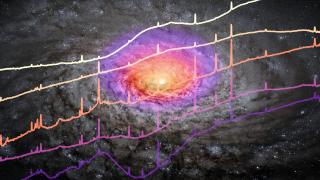Bibcode
Erroz-Ferrer, Santiago; Carollo, C. Marcella; den Brok, Mark; Onodera, Masato; Brinchmann, Jarle; Marino, Raffaella A.; Monreal-Ibero, A.; Schaye, Joop; Woo, Joanna; Cibinel, Anna; Debattista, Victor P.; Inami, Hanae; Maseda, Michael; Richard, Johan; Tacchella, Sandro; Wisotzki, Lutz
Referencia bibliográfica
Monthly Notices of the Royal Astronomical Society, Volume 484, Issue 4, p.5009-5027
Fecha de publicación:
4
2019
Número de citas
103
Número de citas referidas
96
Descripción
We study the physical properties of the ionized gas in local discs using
the sample of 38 nearby ˜108.5-11.2 M⊙
Star-Forming Main-Sequence (SFMS) galaxies observed so far as part of
the MUSE Atlas of Disks (MAD). Specifically, we use all strong emission
lines in the MUSE wavelength range 4650-9300 Å to investigate the
resolved ionized gas properties on ˜100 pc scales. This spatial
resolution enables us to disentangle H II regions from the diffuse
ionized gas (DIG) in the computation of gas metallicities and star
formation rates (SFRs) of star-forming regions. The gas metallicities
generally decrease with radius. The metallicity of the H II regions is
on average ˜0.1 dex higher than that of the DIG, but the
metallicity radial gradient in both components is similar. The mean
metallicities within the inner galaxy cores correlate with the total
stellar mass of the galaxies. On our < 100 pc scales, we find two
correlations previously reported at kpc scales: a spatially resolved
mass-metallicity relation (RMZR) and a spatially resolved SFMS (RSFMS).
We find no secondary dependence of the RMZR with the SFR density. We
find that both resolved relations have a local origin, as they do not
depend on the total stellar mass. The observational results of this
paper are consistent with the inside-out scenario for the growth of
galactic disks.
Proyectos relacionados

Actividad Nuclear en Galaxias: una Perspectiva 3D del Núcleo y su Entorno
Nuestro proyecto puede dividirse en dos líneas principales de investigación. En primer lugar, el estudio de los vientos producidos por cuásares luminosos oscurecidos y del impacto que estos tienen en sus galaxias anfitrionas (retroalimentación del AGN). Para ello hemos obtenido observaciones en el óptico e infrarrojo cercano con el Gran Telescopio
Cristina
Ramos Almeida